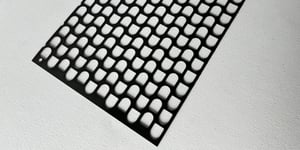It’s been a long day of sobbing over exponential graphs and pulling your hair, but you’re still unsure how to achieve the next step in your growth process.
Regardless of your prototype’s success, increasing the scale of your adhesive production can be challenging. Strouse’s team has years of experience helping clients scale their adhesive solutions efficiently and in a cost-effective manner.
Once you’ve read our tips on scaling up your adhesive for large-scale production, you’ll be prepared to navigate meetings knowing exactly where you plan to scale and have a better understanding of how to achieve your scaling goals through efficient product design and prototyping.
Steps to Scale up Your Prototype
Scaling up your adhesive doesn’t happen overnight; it takes rigorous planning between you and your converter to bring your adhesive from prototype to production successfully.
By following the three steps below, you’ll have an organized framework to overcome doubts about scaling and effectively communicate your needs to your converter.
STEP 1: OPTIMIZE YOUR ADHESIVE DESIGN
Your design might work for an order of 100 parts, but how will it perform when you’re building 100,000 of them?
It’s a common misconception to assume that because a design performs well on a smaller scale, it will continue to behave once you get into larger production orders. However, you might not realize certain manufacturing methods aren’t quick or sustainable enough to support long-term scaling processes.
To increase your current scale of operation, you’ll want to reconsider your chosen method. Methods like laser die cutting are an effective way to gather precise samples for early-stage rapid prototyping, but unfortunately, they’re nowhere near as efficient as using a rotary die cut press when it comes to full-scale production.
Switching to faster production methods, like rotary die cutting, often requires changes to your adhesive design or tolerances to create a reliable manufacturing process.
STEP 2: CONSIDER MATERIAL AND TOLERANCE ADAPTABILITY
As you begin to scale up, consider two specific aspects of adhesive product design and prototyping: your chosen material and tolerance adaptability.
Although rotary die cutting is fast and increases productivity, certain materials and tolerances run poorly through die cut presses. One example of this is spandex, which stretches as the machine begins. Running elastic materials too quickly causes the die cuts to shrink after the tension is released, resulting in poor tolerances.
Scaling up could mean working with your converter to find an alternative material to the one you’ve been using, or figuring out a way to adjust your part so the machine achieves the correct tolerances.
If you’re looking to scale your adhesive production, you’ll want to work alongside a converter to optimize your part design until it reaches the most simple yet effective stage. Have a part design, but still wondering how effective your drawing can be? Get a converter to evaluate your design and we can help you find your ideal production method and help you scale to your desired stage.
STEP 3: INCREASE PRODUCTION VOLUME
To improve upon your production volume, you must first consider the following:
- How well are your current products running on the press?
- What exact quantity are you hoping to achieve as production increases?
- How long will it take to reach this volume?
Even though it may appear frightening, concrete data is your ticket to increasing production volume. In short, you’ll need definitive goals so your converter can prepare for increased production.
For instance, if you come in with specific numbers, like “Our company is hoping to grow from 200 parts per month to one million in a year,” your converter will have the information they need to help you build a comprehensive scaling plan.
If you know the number of units you want within a specific timeframe, you’ll better understand how quickly your production is developing and the budget you’ll use to pay off scaling costs.
Q: Are there costs associated with increased volume?
A: Unfortunately, yes.
We’ve established that laser die cutting isn’t sustainable for extremely large-quantity projects, but the alternative of rotary die cutting requires tools.
Die cut tools vary in price depending on the complexity of your design. A $10,000 tool set doesn’t make sense if you only plan on making a couple hundred parts, but investing in the future might outweigh the immediate tooling cost.
As your production volume increases, the cost of proper tooling will justify itself. Using the right equipment for your soon-to-grow project will eliminate the need to replace smaller or cheaper tools down the road. Plus, if you work with your converter with the open intention of scaling, you’ll ideally only pay for tooling once.
When is the Right Time to Scale Up Your Adhesive?
To be honest, there isn’t one right time for every company to begin scaling production. Instead, it’s better to consider how worthwhile it is for you to invest in future expansion.
Several companies scale up before the design is complete, while others wait for the entire development cycle before agreeing to specific terms. As you might expect, both scenarios have pros and cons.
If you wait to scale, you might accidentally design a difficult part or choose the wrong adhesive for rotary die cutting. This would siphon time from your product development and could cause issues with your converter down the line.
On the other hand, choosing to scale before the design is finalized will allow your converter to offer suggestions on scaling and choosing your tolerances.
Still, trying to decide whether to message an adhesive converter early on about scaling? See for yourself how it can affect the design process:
Originally published: December 14, 2022







